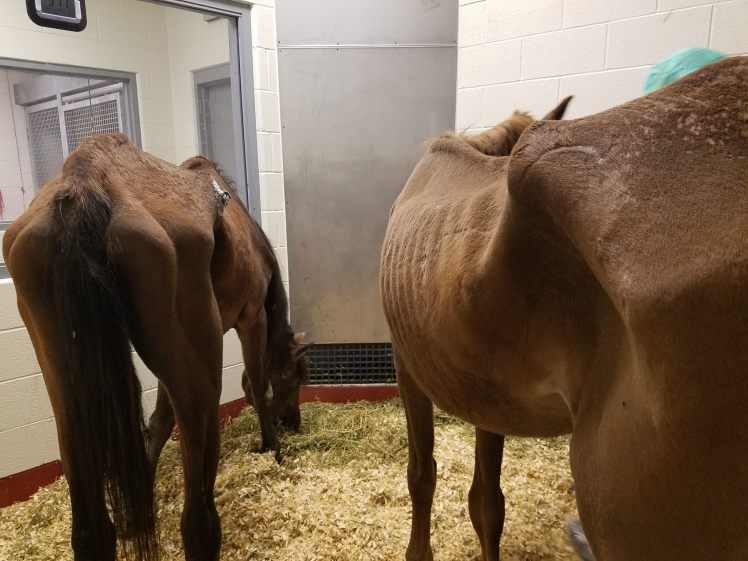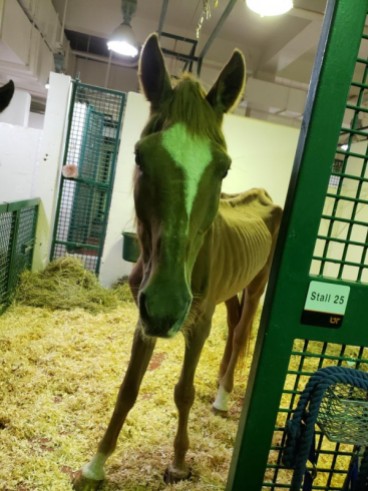Two months ago Horse Haven of Tennessee received a call about three thin horses that needed rescued. They responded, unaware that the horses would be underweight by nearly 700 pounds.
“These guys, this score, is probably once in a lifetime,” said Jocelyn Smith.
Smith, the equine manager at Horse Haven, said the equine rescue usually gets cases of thin horses that need to be rehabilitated. However, horses in the condition Chip and Dale are in are rare.
“We often see horses that are thin,” said Smith. “Just a couple of weeks ago we ended up with one that’s probably a score of two out of nine. That low we see maybe once a year on average.”
On Sept. 13, Horse Haven was alerted to three Arabian horses on a Cleveland quarantine lot. The three horses – a gray mare, a bay mare and a sorrel gelding – stood abandoned in the lot.
Upon arriving at the quarantine lot, Horse Haven assessed the horses’ situation, making sure they would be stable enough to be transported to the UT College of Veterinary Medicine.
The gray mare was unable to be transported. She was so emaciated that she could not stand up.
“Just before arrival, Horse Haven learned the gray mare had nothing left to give. Too weak to stand, she had laid down and would not stand again,” according to the rescue’s website.
The two surviving horses were taken to UTCVM, beginning their road to recovery.

Both horses scored a one on the Henneke body condition score, a universal nine-point system used to determine a horse’s body weight. SmartPak Equine’s website offers an example of this scoring, explaining that a one is “Extremely emaciated. Spinous processes, ribs, tailhead, and tuber coxae and ischia (hip) projecting prominently. Bone structure of withers, shoulders and neck easily noticeable. No fatty tissue can be felt.”
A normal, healthy horse would score between a five to a seven.

Chip, the sorrel gelding, weighed about 370 pounds. Dale, the bay mare, weighed about 350 pounds. A healthy weight for a horse their size and breed would be around 1,000 pounds.
On Oct. 4, both horses were cleared to be taken out of isolation, allowing them to share a stall at UTCVM.

The two horses have spent most of the month since their rescue fighting infections. Chip had also suffered an injury about two weeks prior to being rescued.
“Chip had a severe fracture to his jaw,” explained Smith. “It was an impact, and the fracture actually ran the entire length of his jaw.”
He has spent more time at UTCVM than the bay mare, Dale.
“He did go down – he actually laid down – and did not have the body mass to lift himself back up,” said Smith. “That was a couple of days before they were scheduled to come home, so he stayed to fight a little more infection and to get stronger.”
Dale was cleared to go to Horse Haven’s facility on Oct. 15 but returned to UTCVM on Oct. 20 due to complications.
“Dale actually came home with us for about a week, but unfortunately she came back Saturday after she went down,” Smith said. “Before Saturday, when she laid down, it had probably been in excess of thirty days since she had been off her feet.”
Although horses can nap standing up, the only restful sleep they get is when they lie down. For a healthy horse, getting up is not an issue. For Chip and Dale, however, the process of getting up is extremely difficult, as they lack the required strength to pull themselves up.
Both horses are expected to make a slow but successful recovery.
“We anticipate that it will take these guys anywhere from about ten to twelve months to be comfortable enough for us to say it’s ok,” said Smith.
Horse Haven rescues horses from across the Tennessee area, saving horses from abuse and neglect. Some cases are called-in by worried neighbors, others are called in by authorities.
If you suspect a case of equine abuse or neglect, Horse Haven asks that you contact animal control by calling 911.
Chip and Dale’s story will continue on Horse Haven’s blog as they continue their process of recovery.

